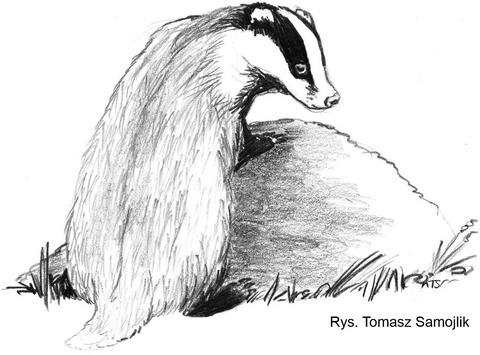Our official English website, www.x-mol.net, welcomes your feedback! (Note: you will need to create a separate account there.)
Fossoriality in a risky landscape: badger sett use varies with perceived wolf risk
Journal of Zoology ( IF 2 ) Pub Date : 2020-10-03 , DOI: 10.1111/jzo.12835 T. A. Diserens 1, 2 , J. W. Bubnicki 1 , E. Schutgens 1 , K. Rokx 1 , R. Kowalczyk 1 , D. P. J. Kuijper 1 , M. Churski 1
Journal of Zoology ( IF 2 ) Pub Date : 2020-10-03 , DOI: 10.1111/jzo.12835 T. A. Diserens 1, 2 , J. W. Bubnicki 1 , E. Schutgens 1 , K. Rokx 1 , R. Kowalczyk 1 , D. P. J. Kuijper 1 , M. Churski 1
Affiliation

|
Many medium‐sized carnivores are fossorial and use burrow systems to reduce predation risk or avoid predators. But fossorial species cannot stay safely underground forever, and they must also risk emerging overground, to forage and find mates. To make this trade‐off effectively and maximize their own fitness, it is imperative they assess how predation risk varies in space and time, and adapt their denning behaviour accordingly. We used European badger (Meles meles) burrows (setts) in Białowieża Forest, Poland as a model for investigating how the denning behaviour of a fossorial mesocarnivore varies across gradients of landscape scale perceived risk imposed by wolves (Canis lupus) and humans, defined as wolf space use and distance to settlements, respectively. We monitored seventeen setts with varying levels of perceived human and wolf risk with camera traps for two months to study three denning behaviours: frequency of badger sett use, frequency of badger sett sharing with other mesocarnivore species and badger emergence time. Frequency of sett use varied relative to perceived wolf but not human risk. Setts in the highest risk areas were used ca. 60% less often than those in the lowest perceived risk areas, and setts with juveniles were only present in areas of lower perceived risk. Food availability, quantified as earthworm abundance in an area of 2.1 km2 around setts, did not affect the frequency setts were used. Emergence time and frequency of sett sharing with other mesocarnivores, which have been proposed to be anti‐predator strategies, did not vary with either perceived risk factor. These results show fossorial species can adapt their use of burrows to the prevailing risk landscape and suggest burrows deserve more attention in studies on the ecological impacts of apex predators.
中文翻译:

危险环境中的软体动物:badge的使用随感知狼的风险而变化
许多中型食肉动物都是窝,并使用洞穴系统来降低捕食风险或避免捕食。但是,重要的物种不能永远安全地呆在地下,它们还必须冒着地上的危险,觅食和寻找伴侣。为了有效地进行权衡并最大限度地提高自身适应性,他们必须评估捕食风险如何随时间和空间变化,并相应地调整其拒绝行为。我们使用波兰比亚沃维耶阿森林(BiałowieżaForest)的欧洲badge(Meles meles)洞穴(定居点)作为模型,调查了中骨食肉动物的凹陷行为在不同的景观尺度梯度下如何变化,而这种梯度是由狼(犬天狼星)造成的)和人类,分别定义为狼空间的使用和到居民点的距离。我们用相机诱捕器监测了17个定居点,它们具有不同程度的感知到的人类和狼危险,研究了三种抑制行为:of定居的使用频率,of定居与其他中生食肉动物物种共享的频率以及badge定生时间。定居点的使用频率相对于感知到的狼而变化,但无人为风险。大约在最高风险区域使用定居点。与那些被认为风险最低的地区相比,这种情况的发生频率要低60%,而只有在那些被认为风险较低的地区,才会出现未成年人的定居点。粮食可供量,按2.1 km 2的面积定量为worm围绕定居点,不影响使用定座频率。与其他中生食肉动物共享定居点的时间和频率,被认为是反掠食者的策略,并没有随任一个风险因素而变化。这些结果表明,穴居物种可以使他们对洞穴的利用适应当前的风险状况,并表明在研究天敌掠食者的生态影响方面,洞穴应得到更多的关注。
更新日期:2020-10-03
中文翻译:

危险环境中的软体动物:badge的使用随感知狼的风险而变化
许多中型食肉动物都是窝,并使用洞穴系统来降低捕食风险或避免捕食。但是,重要的物种不能永远安全地呆在地下,它们还必须冒着地上的危险,觅食和寻找伴侣。为了有效地进行权衡并最大限度地提高自身适应性,他们必须评估捕食风险如何随时间和空间变化,并相应地调整其拒绝行为。我们使用波兰比亚沃维耶阿森林(BiałowieżaForest)的欧洲badge(Meles meles)洞穴(定居点)作为模型,调查了中骨食肉动物的凹陷行为在不同的景观尺度梯度下如何变化,而这种梯度是由狼(犬天狼星)造成的)和人类,分别定义为狼空间的使用和到居民点的距离。我们用相机诱捕器监测了17个定居点,它们具有不同程度的感知到的人类和狼危险,研究了三种抑制行为:of定居的使用频率,of定居与其他中生食肉动物物种共享的频率以及badge定生时间。定居点的使用频率相对于感知到的狼而变化,但无人为风险。大约在最高风险区域使用定居点。与那些被认为风险最低的地区相比,这种情况的发生频率要低60%,而只有在那些被认为风险较低的地区,才会出现未成年人的定居点。粮食可供量,按2.1 km 2的面积定量为worm围绕定居点,不影响使用定座频率。与其他中生食肉动物共享定居点的时间和频率,被认为是反掠食者的策略,并没有随任一个风险因素而变化。这些结果表明,穴居物种可以使他们对洞穴的利用适应当前的风险状况,并表明在研究天敌掠食者的生态影响方面,洞穴应得到更多的关注。


























 京公网安备 11010802027423号
京公网安备 11010802027423号